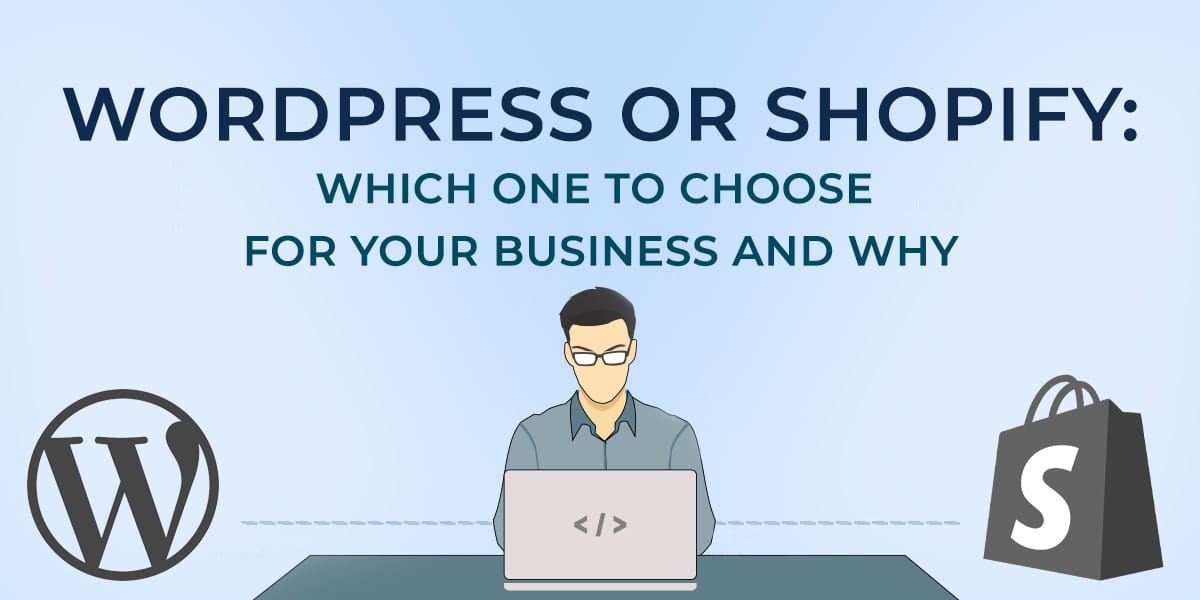WordPress or Shopify: Which One to Choose For Your Business and Why
When it comes to running an online business, where and how you host your site matters. The platform you choose can have a huge impact on your success. You’ll see this difference as you compare payment providers, design options, major SEO factors, and much more.
WordPress and Shopify dominate the online business space. Both platforms provide you with a range of tools for attracting customers and turning a profit. Although, as you likely know, they are far from similar.
At No to The Quo, we’ve worked with plenty of customers across all types of businesses. To be honest, our clients have seen crazy success with both—but that doesn’t mean the choice is irrelevant. You need a solid WordPress and Shopify comparison to know which is right for you and your business.
Below you’ll find an explanation of the pros and cons of both WordPress and Shopify.
What is WordPress?
You may hear WordPress and think blogging… and you would be right. Nowadays though, the company has expanded its offerings to make its users’ sites incredibly Ecommerce-friendly. This has made it a formidable option when comparing platforms to host your business on.
The Business and eCommerce plans are priced at $25 and $45 a month, respectively. Both are viable, but regardless you will find yourself installing the WooCommerce plugin very quickly. This is the main driver of Ecommerce on the WordPress platform, and for good reason. For one, it’s free! Two, it offers a wide variety of functionality for facilitating your business operations.
For this reason, we will mainly be referring to the functions of WooCommerce on the WordPress platform in this article.
WordPress Pros
WordPress makes receiving payments easy. WooCommerce Payments is the platform’s amazing, native payment provider. It’s free to sign up and use, with no transaction fees. There are credit card fees though, with U.S. credit and debit cards fetching a 2.9% fee, and non-U.S. cards racking up a 3.9% fee.
WordPress is the resident boss of design. It’s been their forte for years! The company has over 8,000 themes to choose from for your site, and over 1,200 Ecommerce-focused templates, you can browse to make sure your site is crafted exactly how you and your customers will like it.
There are plenty of marketing tools to help you land sales. WooCommerce is the portal to most other marketing tools that you’ll want to use on your WordPress site. Through WooCommerce, you can download and use a huge variety of tools for marketing.
A great example of this is the plugin Google Listings. This allows you to utilize Google’s shopping page to showcase your own products. It’s an official partner of WooCommerce and has the potential to boost your sales significantly.
Another prime marketing plugin is the official WooCommerce Points and Rewards tool, which can be used to incentivize current and past customers to become return buyers.
WordPress Cons
Tweaking features and designs require a little more know-how. While the possibilities that WordPress offers are extensive and give you plenty of freedom, it’s recommended that you have at least a very basic knowledge of how code works so that you can make small tweaks where you need them.
If you don’t know your way around rudimentary HTML or CSS code, it will likely show. Your design may lack the well-roundedness of comparable Shopify sites, and small code mistakes can cause big issues.
The WordPress plugin system can lend itself to slow loading times. Search Engine Optimization (SEO) is vital for running an online business. As you continue to pile more plugins onto your WordPress site, it can quickly become bogged down.
Besides robbing you of organic traffic, long load times worsen your ranking in Google’s system. To read more about how website loading times (and other factors) can impact your SEO, check out our article 8 On-Site SEO Factors That Matter Most.
What is Shopify?
Shopify is the leader in Ecommerce for the United States market (and many other countries). In fact, it holds 32% of the market share for Ecommerce platforms! It’s popular for a reason: Shopify makes Ecommerce simple and seamless for both merchants and consumers.
Pricing plans for Shopify can range from $29-299/month, with discounts if you opt for a year—or years-long billing plan. There is a 14-day free trial, but frankly, you will need more time than that to dial in all the details. On top of this, there is a small fee to use major credit cards as payment in your store.
Shopify Pros
Designing your site with Shopify is a breeze. When it comes to page design, Shopify has created an intuitive and powerful array of customization options. There is no coding involved, with a wide variety of templates so you design without frustration. Now, if you do prefer to get your hands dirty, the coding is always available to merchants who want to dig a little deeper.
Marketing is made easy with Shopify. For example, one great option they offer is integrated email marketing through the native client Shopify Email. All paying merchants are allowed 2,500 individual emails for free each month, and then are charged a small fee for further email campaigns. Shopify also offers plenty of design options within their email client so you can make sure your marketing matches your brand.
A super cool feature that we love when it comes to Shopify is their slick “Shopcodes.” These are custom QR codes that you can send or print; They can be utilized for offering discounts, adding physical items to a shopping cart, giving out more product info, and more.
Shopify’s abandoned cart recovery feature helps you reclaim lost sales by saving carts with products that have been forgotten. This feature sends an email to the customer at certain intervals to remind them. This is a great marketing tool because it capitalizes on “warm leads” and reaches out in a friendly, helpful way.
Shopify Cons
This premium service comes at a premium price point. Choosing Shopify as your platform for business isn’t going to break the bank, but you are signing up for a more costly experience. Granted, this is a trade-off many are willing to make for the benefits of using Shopify, but the difference in price plans is worth noting.
Simplistic design options mean sacrificing some freedom. While Shopify is certainly built to give you a wide range of themes and customization, it comes at a price (and we’re not talking about the subscription fees). Compared to WordPress, your options are a little more “on the rails.” You can’t go quite as in-depth in terms of coding and such, which means you can only take it so far.
Making the Most of Your Ecommerce Site
At the end of the day, you need an Ecommerce platform that suits your needs, as well as your customers’. This means that neither Shopify nor WrdPress is necessarily the best. Making the best decision for your website means examining your target audience and your business strategy to see which platform offers the right setup for you.
Marketing an Ecommerce business is a complicated balancing act of strategy and engagement. For many business owners, having the experience and power of a professional marketing agency behind their backs is the key to supercharging their Ecommerce success.
Want to see how No to The Quo could help streamline and level up your marketing? Lets chat about Ecommerce—We’ll even buy the coffee!
E-Commerce No To The Quo



